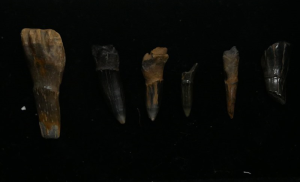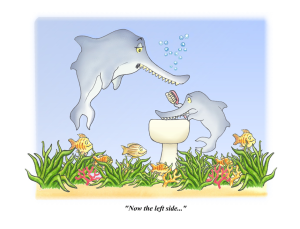Guest Author – Sophie Pollard
Current Palaeobiology MSc Student
Teeth, or at least tooth-like structures, can be found in every jawed vertebrate group living today, and it’s rare to find any lineage which has lost them completely. There is no doubt that teeth have been a key development in vertebrate evolutionary history, but where did they come from in the first place?
The answer is much more complicated than you might expect!
What are the arguments?
Models for the origin of teeth generally boil down to two arguments: outside-in, and inside-out. The outside-in hypothesis originated in the 19th century when researchers started to notice the similarities between the structures of teeth and dermal denticles (the tough scales which make up the skin of sharks and rays).
Both teeth and dermal denticles can be referred to as “odontodes”, a structure consisting of dentine with a hyper-mineralised cap of enamel or enameloid, both of which rest on a bone base for attachment. This similarity led to the belief that teeth are simply specialised scales that migrated inside our fishy ancestors’ mouths some 500 million years ago.
This idea was largely unchallenged until the mid-90s, as evidence started to mount for an alternative hypothesis, turning outside-in, inside-out. The new, “inside-out” model, suggested that teeth evolved multiple different times, originating inside the pharynx of ancient vertebrates completely independently of scales.
No “missing link”, living or fossil, has ever been found showing dermal odontodes extending into the oral cavity, so there is no sure-fire way to prove or disprove either argument, but we can make some observations.
Looking at the fossils
It is clear from the fossil record that dermal denticles appeared before jaws. Many ostracoderm groups had dermal odontodes. Ostracoderms are not a phylogenetic group, but an unofficial name for the many groups of extensively armoured jawless vertebrates which are related to the first jawed vertebrates.

However, the inside-out hypothesis considers this observation irrelevant, as it claims that the origin of teeth predated both dermal scales and jaws.
Conodonts (an extinct group of jawless vertebrates thought to have diverged from the lineage leading to jawed vertebrates more recently than modern jawless vertebrates) had tooth-like structures, and so did the extinct thelodont, Loganellia.

So, teeth came before both jaws and scales? Well, as usual, we have to take the evidence with a grain of salt. There is no way to tell if the tooth-like structures in both of these cases are actually homologous to teeth, or if they simply look the part, and have nothing to do with true teeth.
Teeth in placoderms
Placoderms make up a sister clade to modern chondrichthyans (cartilaginous fishes such as sharks and rays) and Osteichthyans (bony fishes), and in some cases, possess teeth, making them important to the outside-in/inside-out debate.
Many arthrodirans (a particularly derived group of placoderms including Dunkleosteus) had teeth, although there is debate over whether these are true teeth as they lacked an enameloid cap.

The inside-out argument suggests that these structures are not homologous to teeth, and are just one example of the many times teeth have evolved across different lineages, citing the lack of tooth structures in earlier, less derived placoderms as evidence.
This isn’t the case, however, for Romundina, a less derived acanthothoracid placoderm which lived in the early Devonian shallow seas. Not only did Romundina have teeth, but those teeth had enameloid caps, suggesting that arthrodire teeth actually be homologous to true teeth having lost this enameloid cap rather than developing independently.

We know that Outside-In is possible
A paper published in April 2022 lent a little more support to outside in, by confirming that dermal scales are completely capable of developing the kind of complex structure that we see in teeth.
It looked at the rostral denticles (the spikes you see on the elongated snout of a sawfish or sawsharks) of Ischyrhiza mira, an extinct ray (with an appearance much more similar to today’s sawfish) from the late Cretaceous, which would have lived in shallow coastal waters and grown up to about two meters.

Despite being specialised body scales, scanning electron microscopy revealed that the enameloid of I. mira’s rostral denticles was much more intricate than expected, and closely resembles that found in shark teeth. The structure provides an extra level of hardness to the odontode structure, which would have been useful for foraging and self-defence in the case of I. mira.

Although it doesn’t give any conclusive evidence for the debate, this denticle structure lends a lot of support to the plausibility of the outside-in hypothesis, showing that it is possible for external odontodes to form a complex, tooth-like structure, which may have later migrated into the mouths of early vertebrates.
Germ Layers
The use of germ layers is a new addition to the debate. The tissue forming the external epithelium (skin) is derived from ectoderm whilst the epithelial lining of the digestive tract is derived from endoderm. We know that scales require ectoderm-derived epithelium in order to develop, so it stands to reason that if we work out what kind of epithelium cells teeth are growing on, we can work out where they came from. Easy right?
Well, studies are pretty conclusive on one main conclusion: that the epithelium from which teeth grow can have an origin which is ectodermal, endodermal or a mixture of the two. So, whether the cells of an area are derived from ectoderm or endoderm probably doesn’t matter at all, at least in the few species for which we have data (most of what we have is based on animals which are easiest to keep in a lab, not necessarily the best analogy for early vertebrates).
That data does show, however, that the interaction between cells derived from the two layers tends to occur during tooth development, albeit with the surface layer always taking on ectodermal characteristics.
Where do we go from here?
Unless a fossil miraculously turns up to give us all the answers, it’s unlikely that we will ever have a firm explanation for the origin of teeth, but there are things we can do to get just a little bit closer to one.
There is no living creature close enough to the first tooth-possessing vertebrates to accurately represent them in a study of germ layers, but the sample size for these studies could always stand to get a lot wider. Maybe a little (or more likely a lot) more insight into the germ layer contribution to tooth development could paint us a clearer picture of where our dental history began.

Sophie Pollard is a current Palaeobiology MSc student at the University of Bristol.
Article edited by Rhys Charles
References
Cook, T.D. et al. (2022) Complex enameloid microstructure of Ischyrhiza mira rostral denticles. Journal of Anatomy. 241: 616 – 627
Donoghue, P.C.J., & Rücklin, M. (2016) The ins and outs of the evolutionary origin of teeth. Evolution & Development. 18: 19 – 30
Huysseune, A., Cerny, R., & Witten, P.E. (2022) The conundrum of pharyngeal teeth origin: the role of germ layers, pouches, and gill slits. Biological Reviews. 97: 414 – 447
Rücklin, M. et al. (2012) Development of teeth and jaws in the earliest jawed vertebrates. Nature. 491: 748-751
Rücklin, M., & Donoghue, P.C.J. (2015) Romundina and the evolutionary origin of teeth. Biology Letters. 11: 20150326

